Squash plants have both male and female blossoms, and they each play a key role in fruit production.
In this post, I’ll talk about the differences between female vs male squash flowers, and show you tons of photos to help you easily and quickly tell them apart.

It’s important to be able to tell the difference between male and female squash blossoms so you can troubleshoot problems like low yield, and hand pollinate them yourself if necessary.
The best part is that it doesn’t matter what type you have, either winter squash or summer squash varieties. Zucchini, pumpkins, yellow, butternut, spaghetti, crookneck, acorn, and even gourds.
All of them have the same attributes that distinguish the two blooms from each other. Heck, these even apply to all plants in the Cucurbit family, like cucumbers and melons too!
Below I’ll tell you how to distinguish female vs male squash flowers, and show you lots of photos to make it simple for you to easily figure out which one is which.
Do Squash Plants Have Both Male And Female Flowers?
Yes, squash plants have both male and female flowers. The reason it’s important to know how to tell the two apart is that they have very different but equally vital roles in fruit production.
The females are the only ones that can bear fruit. While the main purpose of the males is to pollinate the ladies.
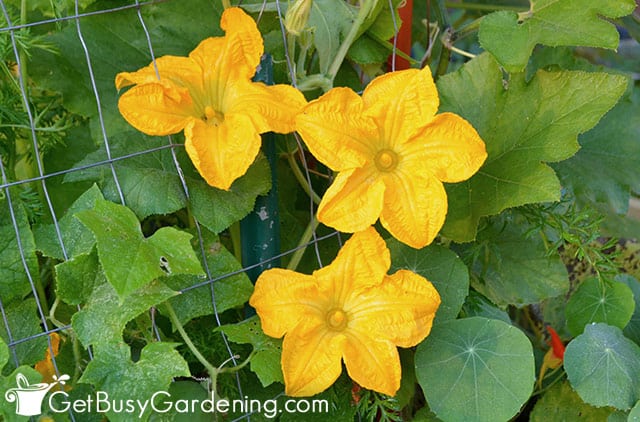
How Can You Tell A Male From A Female Squash Blossom?
There are two easy ways to tell a male from a female squash blossom. One is by looking at the stem, the other is by looking inside of the flowers. In this section I will talk about each one in detail.
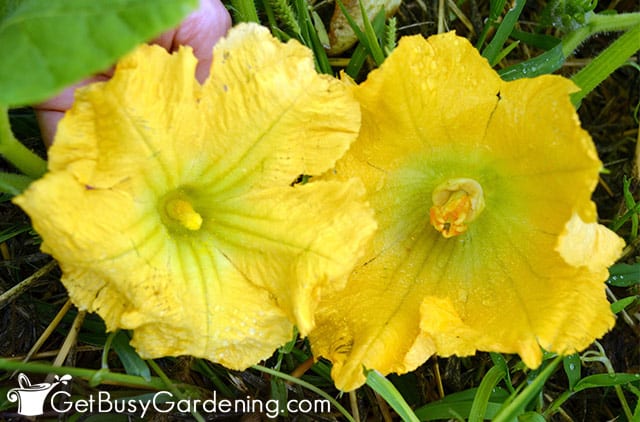
Male Squash Blossoms
The male squash blossoms have one job, and that is pollination. So they look and function very differently than the blooms that produce fruit. Here are their distinct characteristics…
- Stem: The stems below the blossoms are long and thin.
- Center of the blossom: In the center of the flower, there’s a long and narrow protrusion that sticks out. This pollen-covered appendage is called the anther.
- Bloom time: Males form on the plant first and bloom much earlier in the season.
- Location: Since they have longer stems, they protrude much farther out from the middle of the plant.
- Number of flowers: There are almost always a lot more of of the guys on the plant at any given time.
Another fun fact is that even though the other flowers produce your veggies, if you like squash blossoms, these are the ones to eat. They are really good for both cooking and enjoying raw.
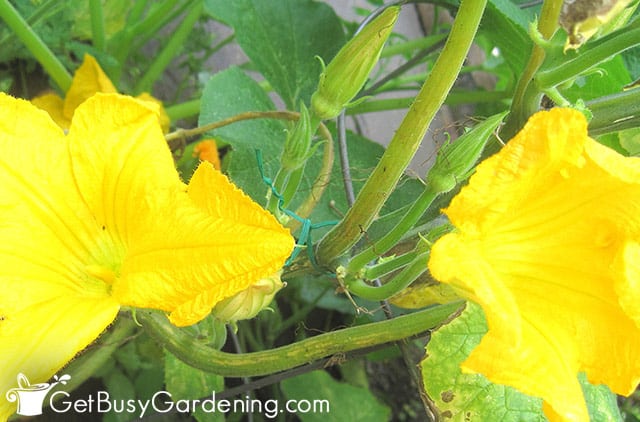
Female Squash Flowers
The female squash flowers are the only ones that will bear fruit, so they look very different from the fellas. Here’s how to identify them just by looking at them…
- Stem: They have a swollen stem that looks like a tiny baby squash. These are embryonic fruits that will eventually turn into a harvestable size if they are pollinated.
- Center of the blossom: The middle of the flower is wider and usually orange in color around the top. It almost looks like a mini flower itself. This is called the stigma.
- Bloom time: Females won’t begin forming on the plant until a few weeks after their partners, and it can take longer for them to open up too.
- Location: Since they don’t have a long stem, they’re located much closer to the center of the plant.
- Number of flowers: There will be less fruit-bearing blossoms on the plant at any given time, which is totally normal.
Related Post: When & How To Harvest Squash
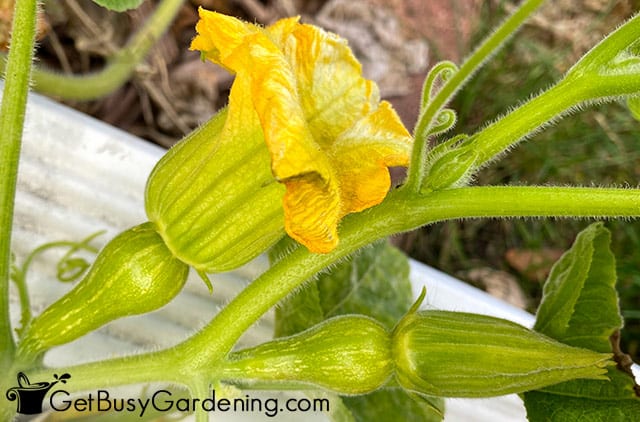
FAQs About Male vs Female Squash Flowers
Now that you know how to tell female vs male squash flowers, here are some questions people often ask me about them. Read through to see if yours is answered here. If not, ask it in the comments section below.
Should I remove male squash blossoms?
There is no need to remove the male squash blossoms from the plant. You certainly can if you plan to eat them, and they are delicious!
However, it’s important to leave at least a few of them on the plant so they can play their part in pollination.
Why do my squash plants only have male flowers?
It’s very common for squash plants to only have male flowers, at least for a time. The reason is that they form much earlier, and will bloom at least a few weeks before their partners do.
So it might simply be too early for the females to form. But lack of fruit-bearing blossoms has other common causes.
Female flowers won’t form if it’s really hot or cold outside, the plants are kept too wet or too dry, or there’s not enough nutrients in the soil.
Now that you know the differences between male vs female squash flowers, you’ll see just how easy it is to tell them apart. This knowledge will help you troubleshoot common problems, and maximize your yields.
Recommended Books
- The Vegetable Gardener’s Bible
- The Week-by-Week Vegetable Gardener’s Handbook
- High-Yield Vegetable Gardening
- Small-Space Vegetable Gardens
More About Squash
More About Vegetable Gardening
- Growing Vegetables: The Ultimate Veggie Garden Guide
- 15 Fast Growing Vegetables To Plant In Your Garden
- How To Tell Determinate vs Indeterminate Tomatoes
Ask your questions or share your tidbits about female vs male squash flowers in the comments below.
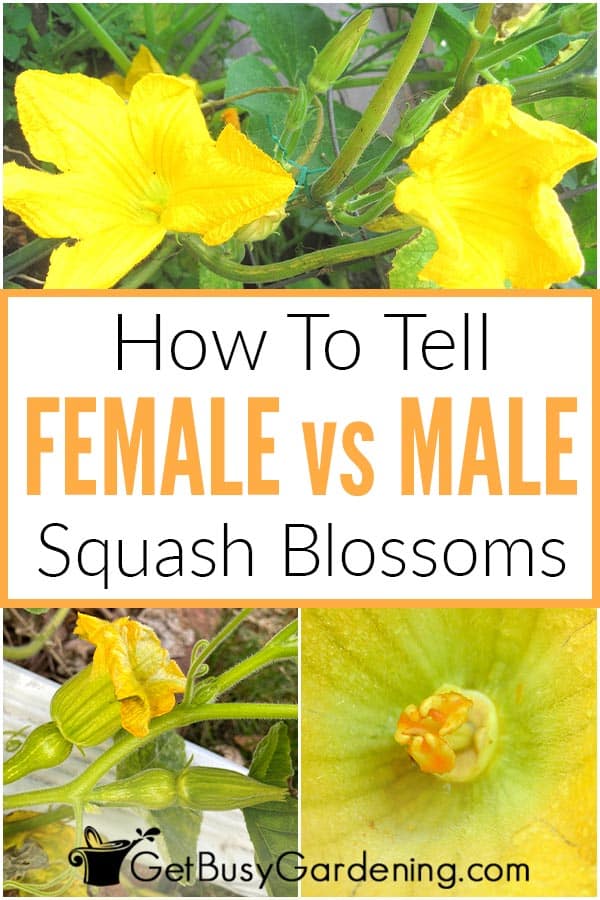
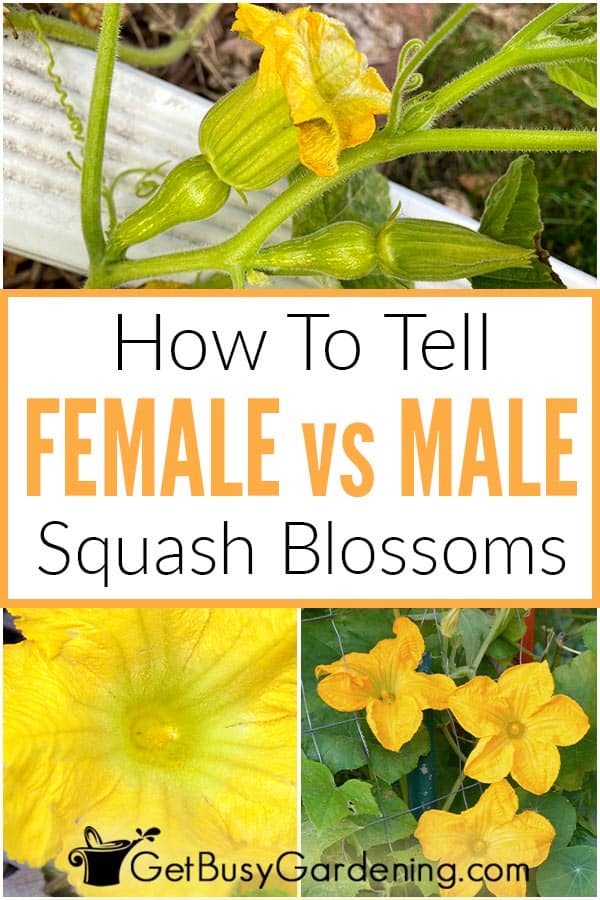
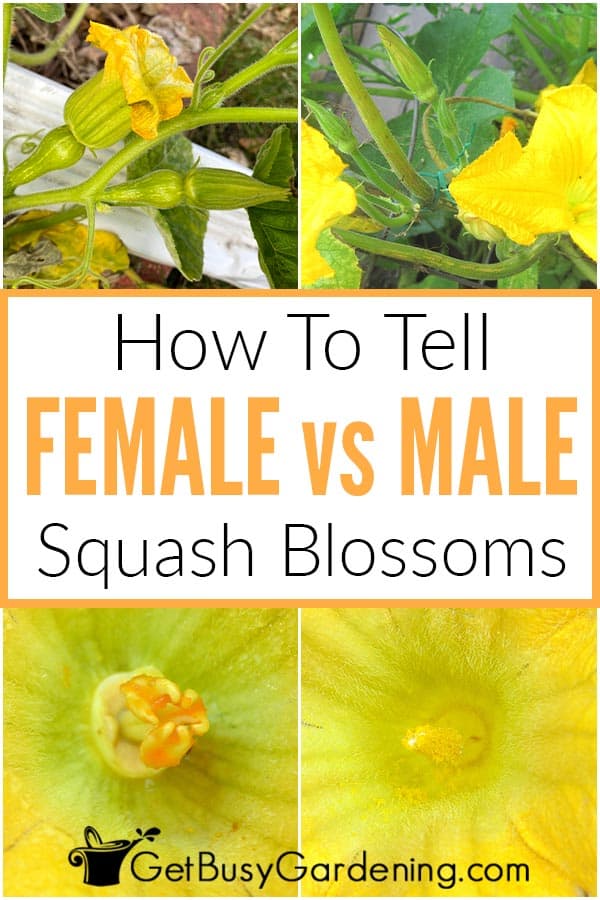


Kathy says
Sometimes the female flowers shrivel and turn brown before they even open to be able to be fertilized. What is happening and can anything be done to prevent it?
Thank you!
Amy Andrychowicz says
It could be caused by improper watering, excessive heat, or a nutrient deficiency in the soil. Check to make sure the plant is getting consistent moisture, and the soil isn’t drying out completely between waterings (it shouldn’t be overly wet either though). If it’s not a watering problem, and it’s not super hot outside, then it’s best to test your soil.
Connie says
Can I save a q-tip with pollen (harvested from the male flower) in a container until a female flower opens?
Amy Andrychowicz says
Great question! Yes, you can save the male pollen for later. I recommend brushing it off into a baggie or a small jar, then storing it in the fridge for later. Use it as soon as the female flowers open, because it will start to lose its viability after a few months.
Sue says
Why are newly formed squash falling off?
Amy Andrychowicz says
That happens when the flowers aren’t being pollinated. Here’s how to hand-pollinate squash flowers to give them a boost.
Cindy says
I’ve heard that you can take the males off and self pollinate with the male flower. Your thoughts?
Amy Andrychowicz says
Yes, here are my step by step instructions to pollinate your squash with pictures. 🙂
Frankie Beckman says
I have only female flowers, what can I do?
Amy Andrychowicz says
Wow, it’s very uncommon for squash plants to produce female flowers before the males form, usually it’s the other way around. I’m guessing it’s just a matter of giving it more time, and eventually the plant will start producing both types. But in the mean time, make sure it’s getting the proper care, including adequate heat, nutrients, and consistent watering (never bone-dry or soggy soil).
Carl Brooks says
Really good information. It’s been some years ago that there were make and female squash plants, and ever since, my harvest has been far better. Beware! If you plan to start a pecan orchard, the male vs. female thing is me even more important, The dealer will gladly sell you ten female plants and thirty males. Knowledge is your key to success.
Amy Andrychowicz says
Yes, knowledge is always key! 🙂